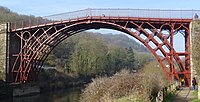
Photo from wikipedia
To evaluate the effect of treating long cracks with the impact crack-closure retrofit (ICR) technique, three rib-to-deck welded specimens with a crack length of about 100 mm were tested. The… Click to show full abstract
To evaluate the effect of treating long cracks with the impact crack-closure retrofit (ICR) technique, three rib-to-deck welded specimens with a crack length of about 100 mm were tested. The metallographic structure, crack section, crack propagation life, and stress variation were analyzed. Finite-element models were also developed, and some optimal values of certain parameters are suggested according to the simulated results. The results show that new crack sources are generated on both sides of the ICR-treated region because of the stress distribution. The fatigue lives of cracked specimens with long cracks are significantly improved by the technique. Considerable residual compressive stress is also induced, and so it is suggested that the optimal impact angle to be applied to real bridges should be 70°. The stress at the weld root is distributed uniformly with the crack closed, and the optimal crack-closure depth is 4 mm. To evaluate the effect of different crack-closure depths in tests, it is recommended that a hot-spot stress method which is extrapolated by three reference points should be adopted.
Journal Title: Journal of Central South University
Year Published: 2019
Link to full text (if available)
Share on Social Media: Sign Up to like & get
recommendations!